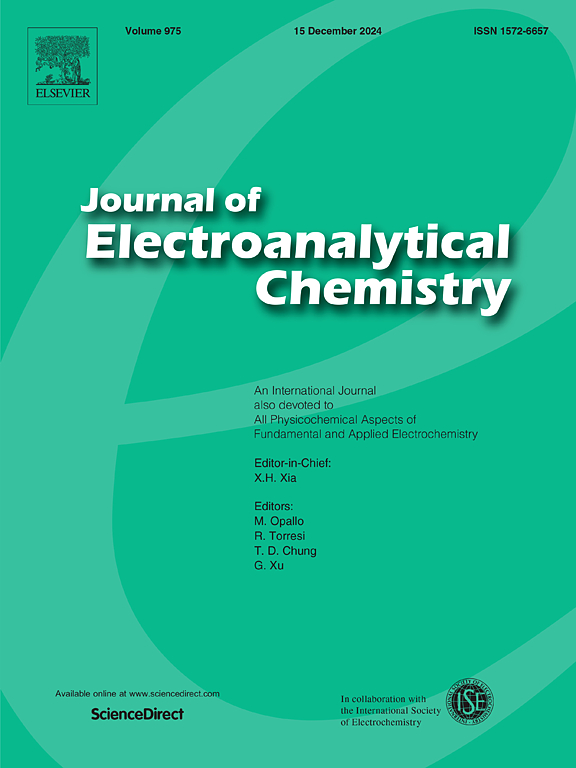Rational design of Co4S3/Ni9S8 heterostructure on nickel foam for efficient bifunctional oxygen and urea oxidation reactions
IF 4.1
3区 化学
Q1 CHEMISTRY, ANALYTICAL
引用次数: 0
Abstract
The development of bifunctional catalysts capable of adapting to complex reaction environments in real time for OER and UOR poses a major challenge during the electrolysis of industrial wastewater, where the concentration of urea is constantly changing. In this work, a series of heterostructured electrocatalysts are synthesized on nickel foam through controlled hydrothermal sulfidation, achieving synergistic enhancement in both oxygen evolution reaction (OER) and UOR. The optimized catalyst, Co4S3/Ni9S8/NF, delivers a current density of 100 mA cm−2 at an ultralow potential of 1.571 V for OER and 1.328 V for UOR, with corresponding Tafel slope of 53.74 mV dec−1 and 3.91 mV dec−1, respectively. Furthermore, the Co4S3/Ni9S8/NF exhibits robust durability across 36 h of continuous operation in a 0.2 M Urea-containing alkaline electrolyte. The excellent activity of Co4S3/Ni9S8/NF can be attributed to its heterostructure, which features vertically growing nanoparticle clusters that enhance electrolyte permeability and active site exposure, as well as interfacial charge redistribution at the heterojunction, thereby optimizing the *OOH adsorption for OER and the urea dehydrogenation kinetics for UOR.
Co4S3/Ni9S8异质结构在泡沫镍上的合理设计,用于高效的双功能氧和尿素氧化反应
在尿素浓度不断变化的工业废水电解过程中,开发能够实时适应复杂反应环境的OER和UOR双功能催化剂是一个重大挑战。本文通过控制水热硫化,在泡沫镍上合成了一系列异质结构电催化剂,实现了析氧反应(OER)和UOR的协同增强。优化后的催化剂Co4S3/Ni9S8/NF在OER和UOR分别为1.571 V和1.328 V的超低电位下,电流密度为100 mA cm−2,相应的Tafel斜率分别为53.74 mV和3.91 mV dec−1。此外,Co4S3/Ni9S8/NF在0.2 M含尿素的碱性电解质中连续运行36小时,表现出强大的耐久性。Co4S3/Ni9S8/NF具有优异的活性可归因于其异质结构,其垂直生长的纳米颗粒簇增强了电解质的渗透性和活性位点暴露,以及异质结处的界面电荷重新分配,从而优化了OER对*OOH的吸附和UOR的尿素脱氢动力学。
本文章由计算机程序翻译,如有差异,请以英文原文为准。
求助全文
约1分钟内获得全文
求助全文
来源期刊
CiteScore
7.80
自引率
6.70%
发文量
912
审稿时长
2.4 months
期刊介绍:
The Journal of Electroanalytical Chemistry is the foremost international journal devoted to the interdisciplinary subject of electrochemistry in all its aspects, theoretical as well as applied.
Electrochemistry is a wide ranging area that is in a state of continuous evolution. Rather than compiling a long list of topics covered by the Journal, the editors would like to draw particular attention to the key issues of novelty, topicality and quality. Papers should present new and interesting electrochemical science in a way that is accessible to the reader. The presentation and discussion should be at a level that is consistent with the international status of the Journal. Reports describing the application of well-established techniques to problems that are essentially technical will not be accepted. Similarly, papers that report observations but fail to provide adequate interpretation will be rejected by the Editors. Papers dealing with technical electrochemistry should be submitted to other specialist journals unless the authors can show that their work provides substantially new insights into electrochemical processes.

 求助内容:
求助内容: 应助结果提醒方式:
应助结果提醒方式:


